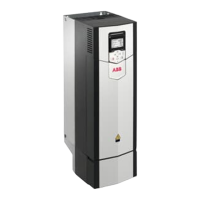2. Selecting the user-defined reference (94.22) as the source for the drive DC
voltage reference (94.21).
Benefits of the DC voltage boost function are:
• Possibility to supply nominal voltage to the motor even when the supply voltage
of the drive is below the motor nominal voltage. Example: A drive that is
connected to 415 V can supply 460 V to a 460 V motor.
• Compensation of a voltage drop due to an output filter, motor cable or input
supply cables.
• Increased motor torque in the field weakening area (that is, when the drive
operates the motor in the speed range above the motor nominal speed).
Use case examples
Example 1: Full motor voltage regardless of supply voltage fluctuations
Supply voltage is 380 V, motor nominal voltage is 400 V. To get motor nominal
voltage at nominal speed regardless of the supply voltage fluctuations:
1. Calculate the required user DC voltage reference: 400 V × √2 = 567 V DC.
2. Set the value of parameter 94.22 to 567 V.
3. Make sure that the value of parameter 99.7 is set to 400 V.
Example 2: Sine filter at the output of the drive
The drive is equipped with a sine filter at the output. Motor cable length is 300 m
(984 ft). Estimated voltage loss across the filter and cable is 40 V. Motor nominal
voltage is 400 V.
To compensate for the 40 V voltage loss at the nominal speed:
1. Calculate the required voltage at the drive output before the sine filter to
compensate for the voltage drop: 400 V + 40 V = 440 V.
2. Calculate the required user DC voltage reference: 440 V × √2 = 622 V.
3. Set the value of parameter 94.22 to 622 V.
If the drive is configured to operate in DTC motor control mode and the ID run is
performed with the output filter and motor cable connected, no other configuration
is needed. The DTC motor control will take care of the estimated losses and boost
drive output voltage without getting limited by parameter 99.7.
If the drive is configured to operate in the scalar motor control mode, change the
value of parameter 99.7 to 440 V to allow the motor control to go up to 440 V at
the drive output at nominal speed.
Program features 107

